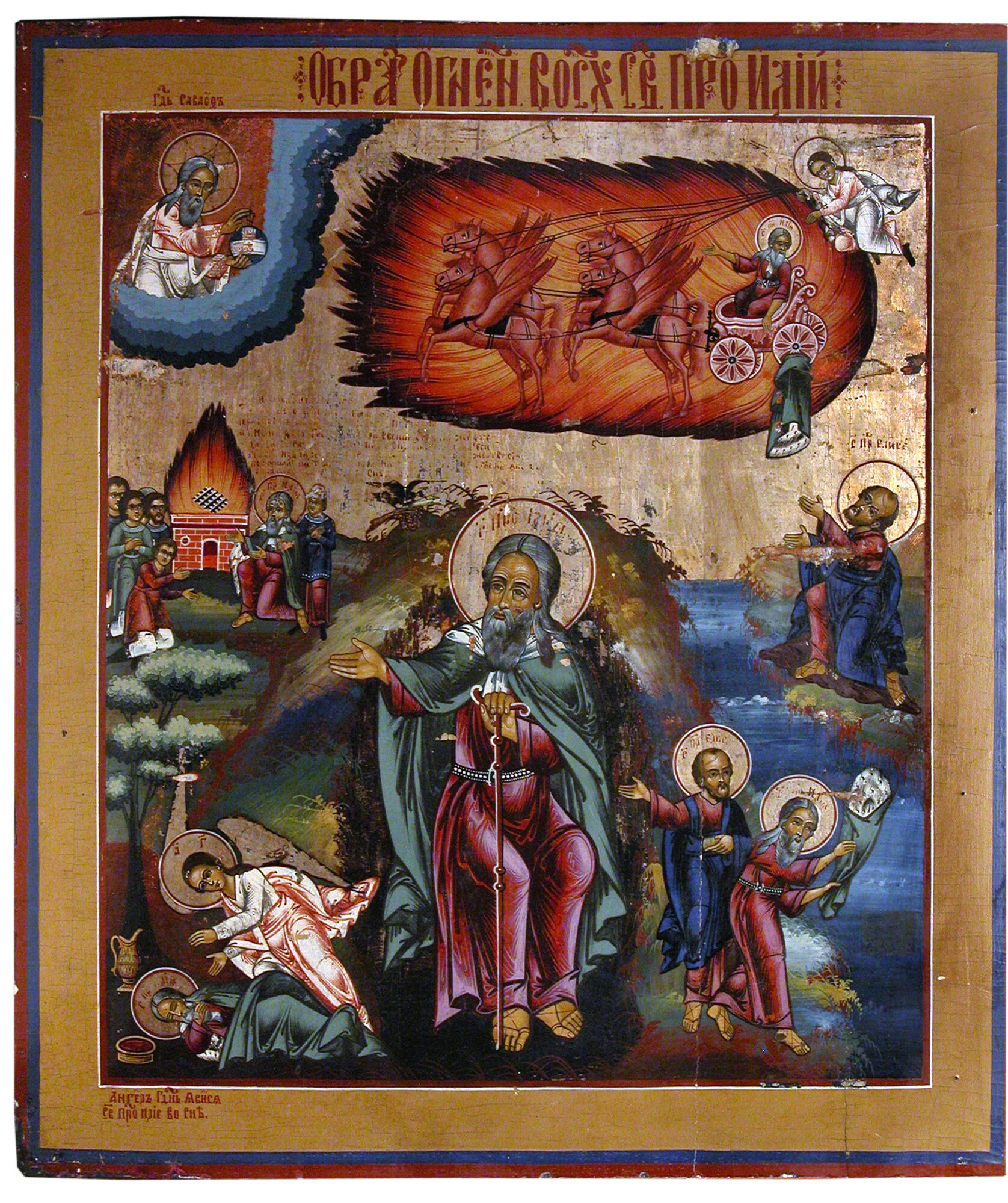Prophet Elijah is one of the most revered saints from the Old Testament in Russia. It’s interesting that in the time of princess Olga, before the official christening of Russia, the temple dedicated to prophet Elijah was built. In the iconography there are a few variants of this saint’s depiction: Prophet Elijah in Silence, The Fiery Ascent, Prophet Elijah and Prophet Elisha.
The plot of the icon The Fiery Ascent of the Prophet Elijah includes a few scenes from the Old Testament. The icon can be referred to the type of the hagiographical icons. In the centre, with the cave on the background, Elijah is depicted leaning on a crook. His right hand is in a gesture accepting the divine blessing. Above is a depiction of the crow, which used to bring him food (vine grapes). In all icons the crow is a permanent fellow traveller of the saint. To the right from the central part is the scene of the Jordan crossing of Elijah and his disciple Elisha, when the waters came apart in front of the prophets.
The Bible tale about Elijah being ascended alive to the heaven in the fiery chariot as a prototype of the Ascension of Christ is shown in the upper part of the icon and is the most emotional scene with the expressiveness of depiction. The chariot with an angel carried by four winged horses is seized by heavenly fire of a red cloud along with Elijah. That is why Elijah is believed to have power over such natural forces as thunder, fire, lightning. It can explain his special popularity among peasants.
This icon was painted in 1906-1907 at Georgy Shalavin’s worksho. There are other icons made at the same workshop in the collection of the museum (The Old Testament Trinity and Dormition of the Mother of God). Georgy Shalavin (1860s – 1930s) came from the dynasty of icon painters living in the Vyaznikovsky district in Vladimir Governorate. In the 1880s Georgy moved to Kargapolskoye village and decided to follow his father’s and grandfather’s footsteps and paint icons. Three mentioned icons may have been made by Georgy Shalavin for the Edinoverie church in Savino village, Kurgan district. The contract dated by 1906 is a confirmation of this theory.
The Presentation of the Blessed Virgin Mary made at the Joseph Khlopotov’s workshop approximately at the same time is also in the exposition of the museum. And while it’s painted in the style of academic painting, with reference to the Western examples, Elijah is still nationally decorative, bright and festive. The iconography itself is shown according to the canon, however, in depiction of the lowly figures and sharp faces one can feel the author’s personal view and manner. The palette is built on the contrast of whitened spaces and bright cinnabar and sky blue colours. The silver base under the lacquer is a background. The icon was painted late, in the early 20th century, but the author intentionally kept clear of the new tendencies drawing the image maximally close to the national origins, the icons of the 15th – 18th centuries.
The plot of the icon The Fiery Ascent of the Prophet Elijah includes a few scenes from the Old Testament. The icon can be referred to the type of the hagiographical icons. In the centre, with the cave on the background, Elijah is depicted leaning on a crook. His right hand is in a gesture accepting the divine blessing. Above is a depiction of the crow, which used to bring him food (vine grapes). In all icons the crow is a permanent fellow traveller of the saint. To the right from the central part is the scene of the Jordan crossing of Elijah and his disciple Elisha, when the waters came apart in front of the prophets.
The Bible tale about Elijah being ascended alive to the heaven in the fiery chariot as a prototype of the Ascension of Christ is shown in the upper part of the icon and is the most emotional scene with the expressiveness of depiction. The chariot with an angel carried by four winged horses is seized by heavenly fire of a red cloud along with Elijah. That is why Elijah is believed to have power over such natural forces as thunder, fire, lightning. It can explain his special popularity among peasants.
This icon was painted in 1906-1907 at Georgy Shalavin’s worksho. There are other icons made at the same workshop in the collection of the museum (The Old Testament Trinity and Dormition of the Mother of God). Georgy Shalavin (1860s – 1930s) came from the dynasty of icon painters living in the Vyaznikovsky district in Vladimir Governorate. In the 1880s Georgy moved to Kargapolskoye village and decided to follow his father’s and grandfather’s footsteps and paint icons. Three mentioned icons may have been made by Georgy Shalavin for the Edinoverie church in Savino village, Kurgan district. The contract dated by 1906 is a confirmation of this theory.
The Presentation of the Blessed Virgin Mary made at the Joseph Khlopotov’s workshop approximately at the same time is also in the exposition of the museum. And while it’s painted in the style of academic painting, with reference to the Western examples, Elijah is still nationally decorative, bright and festive. The iconography itself is shown according to the canon, however, in depiction of the lowly figures and sharp faces one can feel the author’s personal view and manner. The palette is built on the contrast of whitened spaces and bright cinnabar and sky blue colours. The silver base under the lacquer is a background. The icon was painted late, in the early 20th century, but the author intentionally kept clear of the new tendencies drawing the image maximally close to the national origins, the icons of the 15th – 18th centuries.




